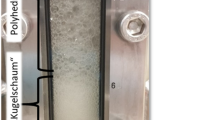Abstract
Cultivable magnetotactic bacteria (MTB) in laboratory can provide sufficient samples for molecular microbiological and magnetic studies. However, a cold-stored MTB strain, such as Magnetospirillum magneticum AMB-1, often loses its ability to synthesize magnetosomes and consequently fails to sense the external magnetic field. It is therefore important to quickly recover vigorous bacteria cells that highly capable of magnetosome producing. In this study, a modified capillary magnetic separation system was designed to recover a deteriorating strain of Magnetospirillum magneticum AMB-1 that long-term cold-stored in a refrigerator. The results show that all cells obtained after a 3-cycle treatment were vigorous and had the ability to produce magnetosomes. Moreover, the 3rd-cycle recovered cells were able to form more magnetosome crystals. Compared with the colony formation method, this new method is time-saving, easily operated, and more efficient for recovering vigorous MTB cells.
Similar content being viewed by others
References
Bahaj A S, Croudace I W, James P A B, Moeschler F D, Warwick P E. 1998. Continuous radionuclide recovery from wastewater using magnetotactic bacteria, J. Magn. Magn. Mater., 184(2): 241–244.
Bahaj A S, James P A B, Croudace I W. 1994. Metal uptake and separation using magnetotactic bacteria, IEEE Trans. Magn., 30(6): 4 707–4 709.
Bellini S. 2009. Further studies on “magnetosensitive bacteria”. Chin. J. Oceanol. Limnol., 27(1): 6–12.
Faivre D, Schüler D. 2008. Magnetotactic bacteria and magnetosomes. Chem. Rev., 108(11): 4 875–4 898.
Fukuda Y, Okamura Y, Takeyama H, Matsunaga T. 2006. Dynamic analysis of a genomic island in Magnetospirillum sp strain AMB-1 reveals how magnetosome synthesis developed. FEBS Lett., 580(3): 801–812.
Funaki M, Sakai H, Matsunaga T. 1989. Identification of the magnetic poles on strong magnetic grains from meteorites using magnetotactic bacteria, J. Geomagn. Geoelectr., 41(1): 77–87.
Harasko G, Pfutzner H, Futschik K. 1995. Domain analysis by means of magnetotactic bacteria, IEEE T. Magm., 31(2): 938–949.
Jogler C, Schüler D. 2006. Genetic analysis of magnetosome biomineralization. In: Schüler, D. ed. Magnetoreception and magnetosomes in bacteria. Sringer-Verlag press, Berlin. p. 133–161.
Kalmijn A J. 1981. Biophysics of geomagnetic field detection, IEEE Trans. Magn., 17(1): 1 113–1 124.
Komeili A, Vali H, Beveridge T J, Newman D K. 2004. Magnetosome vesicles are present before magnetite formation, and MamA is required for their activation, Proc. Natl. Acad. Sci. U. S. A., 101(11): 3 839–3 844.
Li J H, Pan Y X, Chen G J, Liu Q S, Tian L X, Lin W. 2009. Magnetite magnetosome and fragmental chain formation of Magnetospirillum magneticum AMB-1: transmission electron microscopy and magnetic observations. Geophys. J. Int., 177(1): 33–42.
Lin W, Li J H, Schüler D, Jogler C, Pan Y X. 2009. Diversity analysis of magnetotactic bacteria in Lake Miyun, northern China, by restriction fragment length polymorphism, Syst. Appl. Microbiol., In Press, Corrected Proof (doi:10.1016/j.syapm.2008.1010.1005
Lin W, Tian L X, Li J H, Pan Y X. 2008. Does capillary racetrack-based enrichment reflect the diversity of uncultivated magnetotactic cocci in environmental samples? FEMS Microbiol. Lett., 279(2): 202–206.
Lins U, Freitas F, Keim C, de Barros H, Esquivel D, Farina M. 2003. Simple homemade apparatus for harvesting uncultured magnetotactic microorganisms. Braz. J. Microbiol., 34(2): 111–116.
Matsunaga T, Sakaguchi T, Tadokoro F. 1991. Magnetite formation by a magnetic bacterium capable of growing aerobically. Appl. Microbiol. Biotechnol., 35(5): 651–655.
Matsunaga T, Suzuki T, Tanaka M, Arakaki A. 2007. Molecular analysis of magnetotactic bacteria and development of functional bacterial magnetic particles for nano-biotechnology. Trends Biotechnol., 25(4): 182–188.
Pan H M, Zhu K L, Song T, Yu-Zhang K, Lefevre C, Xing S, Liu M, Zhao S J, Xiao T, Wu L F. 2008. Characterization of a homogeneous taxonomic group of marine magnetotactic cocci within a low tide zone in the China Sea. Environ. Microbiol., 10(5): 1 158–1 164.
Schüler D. 2008. Genetics and cell biology of magnetosome formation in magnetotactic bacteria. FEMS Microbiol. Rev., 32(4): 654–672.
Schultheiss D, Schüler D. 2003. Development of a genetic system for Magnetospirillum gryphiswaldense. Arch. Microbiol., 179(2): 89–94.
Seong S, Park T H. 2001. Swimming characteristics of magnetic bacterium, Magnetospirillum sp AMB-1, and implications as toxicity measurement. Biotechnol. Bioeng., 76(1): 11–16.
Ullrich S, Kube M, Schübbe S, Reinhardt R, Schüler D. 2005. A hypervariable 130-kilobase genomic region of Magnetospirillum gryphiswaldense comprises a magnetosome island which undergoes frequent rearrangements during stationary growth. J. Bacteriol., 187(21): 7 176–7 184.
Wolfe R S, Thauer R K, Pfennig N. 1987. A capillary racetrack method for isolation of magnetotactic bacteria. FEMS Microbiol. Ecol., 45(1): 31–35.
Author information
Authors and Affiliations
Corresponding author
Additional information
Supported by the Natural Science Foundation of Shandong Province, China (No. 2006ZRB01973), and the National Natural Science Foundation of China (Nos. 40821091, 40325011).
Rights and permissions
About this article
Cite this article
Li, J., Ge, X., Zhang, X. et al. Recover vigorous cells of Magnetospirillum magneticum AMB-1 by capillary magnetic separation. Chin. J. Ocean. Limnol. 28, 826–831 (2010). https://doi.org/10.1007/s00343-010-9068-4
Received:
Accepted:
Published:
Issue Date:
DOI: https://doi.org/10.1007/s00343-010-9068-4




